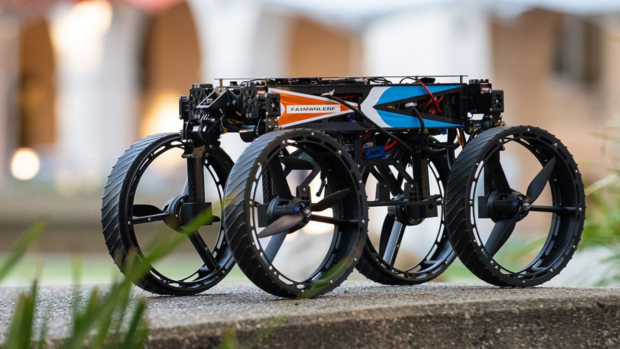California Institute of Technology (Caltech) researchers have developed a groundbreaking robot called the Multi-Modality Mobility Morphobot (M4) that will be part of NASA’s upcoming Mars exploration. The M4 is capable of transforming from a four-wheeled vehicle to a drone-like helicopter within seconds. The Caltech team stated, “We are currently undergoing testing at NASA to assess its transforming capabilities during landing.” This innovative robot embodies the progress of robotics, which aims to delegate dangerous or repetitive tasks to machines. The M4 will fulfill this purpose by conducting ground and air surveys on the Red Planet, potentially revolutionizing various sectors such as disaster management and supply chain logistics. In this article, we will delve into the functionality of Caltech’s M4 robot and explore its real-world applications. Additionally, we will discuss similar projects from NASA and other experts.
When you first see the Multi-Modality Mobility Morphobot, it appears unimpressive, resembling a remote-controlled toy car. However, it surprises observers when its wheels unfold, revealing embedded rotors that enable it to take flight. After completing its aerial maneuvers, the M4 can retract its rotors and move around as a four-wheeled vehicle again. Furthermore, the robot showcases a unique method of climbing steep surfaces. Contrary to popular belief, it does not rely on floating to ascend; instead, its rear wheels transform into rotors, propelling the two front wheels forward. The Space.com YouTube demonstration video explains that excessive rotor usage quickly depletes the robot’s energy, making the two-wheel pushing technique a more energy-efficient approach. While this may seem impractical on Earth, it proves invaluable on Mars, as the robot cannot recharge itself using power outlets in outer space, and solar power is unreliable. Moreover, the researchers at Caltech drew inspiration from nature, particularly animals, when designing the M4. They published their findings in Nature Communications, highlighting how the biomimicry of animals’ appendage repurposing contributes to the robot’s diverse capabilities. By utilizing its components as wheels, thrusters, and legs, the M4 can navigate various terrains, both in the air and on land.
The M4 robot has garnered significant interest from various organizations. Mory Gharib, a researcher at Caltech, expressed surprise at the sudden attention the project received. Multiple Los Angeles fire departments, for instance, have reached out to the team, recognizing the potential of the transforming robot for first responders. Gharib explains, “This is a game-changer for first responders because it allows for landing in a safe area and subsequently driving into the situation.”
In addition to the M4, NASA is also developing another robot called Valkyrie. This humanoid robot will assist astronauts in future space missions, scouting areas to ensure safety for human exploration. However, its initial deployment is on Earth, where it oversees oil rigs at a Woodside Energy facility in Western Australia. NASA aims to leverage this experience to enhance the design of robots for dirty and hazardous environments, such as those found on the moon during future Artemis missions.
Meanwhile, Japanese startup Tsubame has unveiled Archax, a 15-foot-tall transforming robot. Archax can retract its wheels to stand upright and expand them to move as a four-wheeled vehicle. It possesses articulated fingers, hands, and arms, enabling it to manipulate objects. Interestingly, Archax can even be ridden like a vehicle. However, with a price tag of $2.5 million, the robot remains inaccessible to most individuals. Nevertheless, Archax has the potential to revolutionize various industries by inspiring the development of innovative robotics applications.
In conclusion, the Multi-Modality Mobility Morphobot (M4) is an extraordinary robot capable of transforming from a four-wheeled vehicle to a flying drone. It will undoubtedly play a significant role in NASA’s upcoming missions. This year promises exciting developments for space exploration enthusiasts, as NASA has unveiled several projects. Other countries, including India, have also embarked on explorations of the stars, often employing technologies that may have practical applications in our daily lives. Stay informed about these groundbreaking innovations on Inquirer Tech before they become mainstream.
Denial of responsibility! VigourTimes is an automatic aggregator of Global media. In each content, the hyperlink to the primary source is specified. All trademarks belong to their rightful owners, and all materials to their authors. For any complaint, please reach us at – [email protected]. We will take necessary action within 24 hours.


